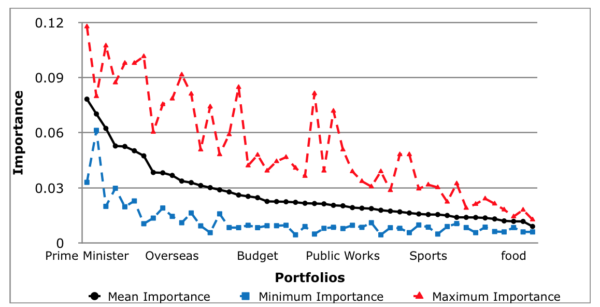In coalitions, parties tend to receive their proportional share of ministries
Coalitions are the norm across Europe, where proportional electoral systems tend to be the norm and majority governments are thus scarce. Here, Cristina Bucur looks at ‘who gets what’ and finds that, when the importance of cabinet posts is taken into account, small and big parties alike tend to receive their fair share of the ministerial prize.

Credit: Dennis Jarvis, CC BY SA 2.0
General elections seldom grant the majority of legislative seats to a single party in Europe’s parliamentary democracies. Multi-party governments are therefore the norm rather than the exception.
How government partners divide seats at the cabinet table is a hotly debated question. Political scientists expect formateur parties (i.e. the ones that get to move first in the game of government formation) to secure more than their fair share of cabinet posts. Yet, empirical studies find that the proportion of ministries each coalition member receives is nearly proportional to the legislative seats it contributes to the government coalition. Contrary to expectations, smaller parties tend to receive slightly more than their proportional share of ministries. This contradiction between theory and empirics is known as the “paradox of portfolio allocation”.
Not all cabinet posts carry the same weight
Notwithstanding the robustness of the empirical regularity characterizing the proportional distribution of ministerial portfolios, doubts remain about how differences in the valuation of portfolios affect their allocation. The challenge is not only to determine whether government parties receive their fair share of cabinet payoffs once the importance of individual ministerial posts is taken into consideration, but also to develop a measure of portfolio importance that takes time and context into account.
One popular solution is to estimate portfolio salience from expert surveys. However, expert judgements have been challenged for not being able to capture variation in the importance of cabinet posts over time. Another option is to identify data sources that provide context-sensitive measures of portfolio importance that vary from one government to another. Cabinet membership lists that accompany the appointment of new governments can be used to extract this kind of information in many countries. Government composition is rarely listed in alphabetical order in official documentation, implying an informal hierarchy of some sort among cabinet posts.
The formal order of ministers has legal and political consequences. For example, executive decrees accompanying the appointment of new governments in Portugal provide information about the cabinet structure and the formal order of ministers. Similarly, the appointment of French and Romanian governments is sanctioned by presidential decrees listing cabinet members and their departmental jurisdictions hierarchically. Until recently, cues about the hierarchy of cabinet members in Turkey have been provided by the order of signatures on Council of Ministers’ decisions. Greek Prime Ministers are also known for changing the hierarchy of ministries according to their priorities.
The examples above suggest that one can use factual data to map the pecking order of cabinet posts. Access to official documents and other primary sources documenting the appointment of new governments can correct important shortcomings associated with expert judgements. First, the availability of data sources corresponding to individual governments can be used to establish fully comprehensive lists of ministries, including posts that existed only for short periods of time. Second, changes in the hierarchy of posts from one government to another can be used to compute importance scores that vary over time. A more finely grained measure of portfolio importance can be constructed in this way and used to highlight the political circumstances under which coalition parties receive more or less than their fair share of the ministerial prize.
In a recent article I proposed a new method of measuring portfolio salience using official records of cabinet appointments. This work focused on the Fifth French Republic, where government formation centres on the distribution of cabinet posts. Coalition-building is short and the main topic of negotiation between the president, the PM and party leaders is portfolio allocation. Due to the lack of a formal investiture requirement in parliament, the government officially exists from the president’s appointment act, which lists the names and jurisdictions of cabinet members in a hierarchical order.
Some might argue that the president’s bargaining advantage in cabinet formation could result in more important portfolios being allocated to the presidential party or assigned to non-partisan ministers. This is precisely one of the aspects that can be captured by a finely grained measure of portfolio importance.
Cabinet rankings and portfolio importance
How does a more nuanced way of weighting portfolios (i.e. according to their position in formal cabinet rankings) affect the relationship between party resources and cabinet payoffs? To answer this question, I used the ordres protocolaires to compile a list of French ministries in the Fifth Republic. Salience scores for single posts in each government as well as average portfolio scores across the time period under study were computed using different functions (i.e. linear, reciprocal, exponential etc.) to convert ordinal rankings into interval scores of portfolio importance. The figure below illustrates the importance scores obtained for a set of portfolios that appeared in at least five governments.
Importance of cabinet posts in the Fifth Republic (1959-2014)

Testing the new measure on the French data set of portfolio allocations shows an almost perfect one-to-one linkage between seat contributions and salience-weighted portfolio payoffs. The near-elimination of the small-party bias provides an ideal setting to look for factors that account for substantial deviations from the proportionality norm under different political circumstances.
The way in which portfolio importance reduces the small-party bias is explained by the case of parties with a small seat share that receive one extra post. For example, consider the case of the Green Party in the Socialist-led cabinet formed by Jean-Marc Ayrault in May 2012. Although the 2% share of parliamentary seats this party brought to the government coalition entitled it to one portfolio according to the proportionality norm, the Greens received two seats at the cabinet table. Taking a close look at the positions of the two portfolios in the cabinet hierarchy reveals a high qualitative difference between them, as they were placed 7th and 31st in the 35-seat cabinet. Thus, the contribution of the second portfolio to the coalition payoffs obtained by the party was double the amount of its fair share of the ministerial prize in quantitative terms but rather negligible when considered in terms of its importance.
This example shows that while the small-party bias cannot be eliminated completely, finding a way to capture differences in the size of ministerial prizes can significantly reduce the artifact generated by the distribution of extra portfolios with a negligible importance. This is also a way to minimize the impact of ‘artificial ministries’ on the fixed total value of the ministerial prize when new offices are established simply to increase the number of available jobs and ease the formation of a coalition.
What next?
The strict proportionality of portfolio allocation in the Fifth French Republic may appear as a surprising result, given the presence of a head of state with a strong role in government formation. More work is needed to explore competing hypotheses about how presidents influence the distribution of ministerial spoils in parliamentary systems. On the one hand, the increase in bargaining power associated with the presidency could lead to expectations that deviations from proportionality advantage the president’s party. Conversely, if one believes in the idea of a presidency ‘above parties’, then the proportionality of party resources and coalition payoffs could be the deliberate result of presidential action.
To a certain extent, the pecking order of portfolios tells a partial story of the coalition bargaining process. The rankings are endogenous to the formation process and inter- or intra-party negotiations between political heavyweights take place behind closed doors. Therefore, sometimes it is difficult to tell if changes in the protocol order of ministries reflect new policy priorities or the strong bargaining position of important politicians.
The answer is probably somewhere in the middle. While ideological preferences matter when coalition partners bargain over ministerial posts, parties are also driven by the ‘market value’ of cabinet positions. Whether the trade-off between policy-valued posts and ministry-specific salience is reflected in the pecking order of portfolios is a question for future investigations. One could check the match between the formal ranking of ministries and the emphasis laid on corresponding policy issues in coalition agreements. Cross-temporal variation in the importance of individual ministerial posts could also be used to test whether institutionally strong presidents and/or PMs are more likely to take advantage of their positions to change the hierarchy of ministries according to their policy priorities.
Altogether, providing variation in both policy payoffs and general portfolio importance from one cabinet to another opens more opportunities to uncover national and cross-national determinants of portfolio allocation.
—
Note: this post represents the views of the author and not those of Democratic Audit or the LSE. Please read our comments policy before posting.
—
Cristina Bucur is Assistant Professor/Postdoctoral Fellow at the Department of Political Science, University of Oslo.





 Democratic Audit's core funding is provided by the Joseph Rowntree Charitable Trust. Additional funding is provided by the London School of Economics.
Democratic Audit's core funding is provided by the Joseph Rowntree Charitable Trust. Additional funding is provided by the London School of Economics.
In coalitions, parties tend to receive their proportional share of ministries https://t.co/7OyHNuhBdb
In coalitions, parties tend to receive their proportional share of ministries https://t.co/rhC6c5UTxR
In coalitions, parties tend to receive their proportional share of ministries https://t.co/54pv47sbsN
In coalitions, parties tend to receive their proportional share of ministries https://t.co/9ZkHyB7Kld
A look into what goes into choosing which parties nominate cabinet posts in #CoalitionBuilding via @democraticaudit https://t.co/99h0VnIGSt
In coalitions, smaller parties tend to receive slightly more than their proportional share of ministries https://t.co/wvthq2qZV3
In coalitions, smaller parties tend to receive slightly more than their proportional share… https://t.co/AUb1Vd23n1 https://t.co/fDSnufo1db